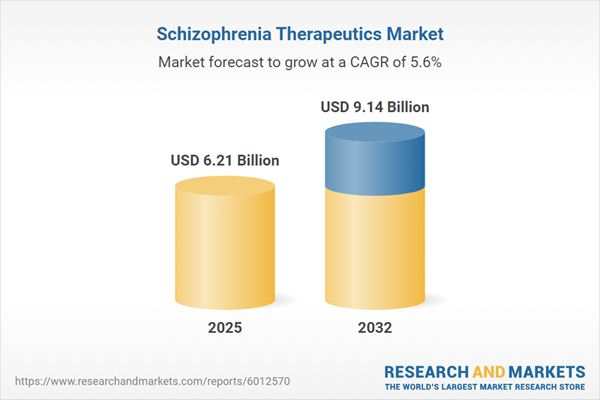Speak directly to the analyst to clarify any post sales queries you may have.
The schizophrenia therapeutics market is undergoing a dynamic transformation as decision-makers seek advanced solutions that address unmet clinical and operational needs. Innovative therapies, evolving patient preferences, and new supply chain realities are reshaping the industry outlook.
Market Snapshot: Schizophrenia Therapeutics Market Growth and Trends
The schizophrenia therapeutics market expanded from USD 5.89 billion in 2024 to USD 6.21 billion in 2025 and is projected to sustain a CAGR of 5.63% to reach USD 9.14 billion by 2032. This trajectory underscores a shift driven by heightened investment in innovative formulations, digital health integration, and increased focus on real-world patient outcomes. Rising demand for therapies that improve beyond symptom management—including cognition and day-to-day functioning—continues to influence global market direction.
Scope & Segmentation
- Therapies: Cognitive-behavioral therapy, electroconvulsive therapy, family therapy, injectable medications, and oral medications.
- Therapeutic Classes: First-generation antipsychotics, second-generation antipsychotics, mood stabilizers, selective serotonin reuptake inhibitors.
- Mechanisms of Action: Dopamine receptor antagonists, glutamate modulators, serotonin-dopamine activity modulators.
- Formulation Types: Inserts and patches, liquid solutions, solid tablets.
- End Users: Homecare, hospitals, mental health clinics, research institutes.
- Patient Settings: Inpatient and outpatient care.
- Patient Demographics: Adult, geriatric, pediatric segments.
- Regions: Americas (including United States, Canada, Mexico, Brazil, Argentina, Chile, Colombia, Peru), Europe, Middle East & Africa (with countries such as UK, Germany, France, Russia, UAE, Saudi Arabia, South Africa, and others), and Asia-Pacific (including China, India, Japan, Australia, South Korea, Indonesia, Thailand, Malaysia, Singapore, Taiwan).
- Companies: Major participants include AbbVie, Acadia, Alkermes, Amneal, Astellas, AstraZeneca, BioXcel, Boehringer Ingelheim, Bristol Myers Squibb, Cipla, Delpor, Dr. Reddy’s, Eli Lilly, Gedeon Richter, GlaxoSmithKline, Glenmark, Johnson & Johnson, Lundbeck, Lupin, Luye Pharma, Lyndra, Meiji, Merck, Neurocrine, Novartis, Otsuka, Pfizer, Reviva, Sanofi, Sumitomo, Sun Pharmaceutical, Takeda, Teva, Torrent, and Vanda Pharmaceuticals.
Key Takeaways for Senior Decision Makers
- Diversified portfolios combining digital health solutions and novel drug mechanisms are gaining traction for enhancing adherence and long-term outcomes.
- Collaboration among biopharma, academia, and advocacy groups accelerates clinical development and aligns new therapies with real-world patient and caregiver needs.
- Regulatory flexibility, including adaptive trial designs and expedited pathways, supports the rapid introduction of differentiated treatments targeting cognitive and negative symptoms.
- Regional nuances in access, health technology assessments, and payer expectations shape market penetration strategies for both established and emerging products.
- Integrated pipelines with advanced non-pharmacological interventions are enabling more comprehensive solutions, increasing differentiation in a competitive landscape.
- Early-stage investments are increasingly focused on holistic models, combining pharmacological and psychosocial interventions tailored to specific demographic or care settings.
Tariff Impact: Navigating U.S. Policy Changes
New United States tariffs entering into effect in 2025 are set to increase input costs for imported active pharmaceutical ingredients and formulations. Companies are reassessing supplier networks and regional production strategies to minimize risk and maintain market competitiveness. Payers may introduce more stringent value assessments, while contractual negotiations are evolving to address tariff pass-throughs and protect patient access to vital therapies.
Methodology & Data Sources
This report utilizes a blend of secondary research—including peer-reviewed literature, industry analyses, and regulatory filings—combined with direct interviews from clinical and commercial leaders. Quantitative validation, triangulation, and expert consultation ensure robust coverage of pipeline developments, pricing shifts, and regulatory influences.
Why This Report Matters
- Actionable insights empower executive teams to adapt rapidly to changing regulatory, clinical, and supply chain landscapes.
- The segmentation enables organizations to uncover new commercial opportunities by targeting emerging therapeutic and demographic niches.
- Comprehensive competitor analysis highlights areas for strategic partnerships and investments in pipeline innovation.
Conclusion
The schizophrenia therapeutics market is evolving through cross-sector collaboration, targeted innovation, and patient-centric models. Senior leaders who prioritize integrated, real-world ready solutions will be positioned to drive lasting value and patient benefit.
Additional Product Information:
- Purchase of this report includes 1 year online access with quarterly updates.
- This report can be updated on request. Please contact our Customer Experience team using the Ask a Question widget on our website.
Table of Contents
3. Executive Summary
4. Market Overview
7. Cumulative Impact of Artificial Intelligence 2025
Companies Mentioned
The companies profiled in this Schizophrenia Therapeutics market report include:- AbbVie Inc.
- Acadia Pharmaceuticals Inc.
- Alkermes Plc
- Amneal Pharmaceuticals, LLC
- Astellas Pharma Inc.
- AstraZeneca plc
- BioXcel Therapeutics, Inc.
- Boehringer Ingelheim International GmbH
- Bristol Myers Squibb Company
- Cipla Limited
- Delpor, Inc.
- Dr. Reddy’s Laboratories Ltd.
- Eli Lilly and Company
- Gedeon Richter Plc
- GlaxoSmithKline plc.
- Glenmark Pharmaceuticals Limited
- Johnson & Johnson Services, Inc.
- Lundbeck A/S
- Lupin Limited
- Luye Pharma Group Ltd
- Lyndra Therapeutics Inc
- Meiji Holdings Co., Ltd.
- Merck & Co., Inc.
- Neurocrine Biosciences, Inc.
- Novartis AG
- Otsuka Holdings Co., Ltd.
- Pfizer Inc.
- Reviva Pharmaceuticals Holdings, Inc.
- Sanofi S.A
- Sumitomo Pharma Co., Ltd.
- Sun Pharmaceutical Industries Limited
- Takeda Pharmaceutical Company Limited
- Teva Pharmaceutical Industries Ltd.
- Torrent Pharmaceuticals Ltd.
- Vanda Pharmaceuticals Inc.
Table Information
| Report Attribute | Details |
|---|---|
| No. of Pages | 185 |
| Published | November 2025 |
| Forecast Period | 2025 - 2032 |
| Estimated Market Value ( USD | $ 6.21 Billion |
| Forecasted Market Value ( USD | $ 9.14 Billion |
| Compound Annual Growth Rate | 5.6% |
| Regions Covered | Global |
| No. of Companies Mentioned | 36 |









